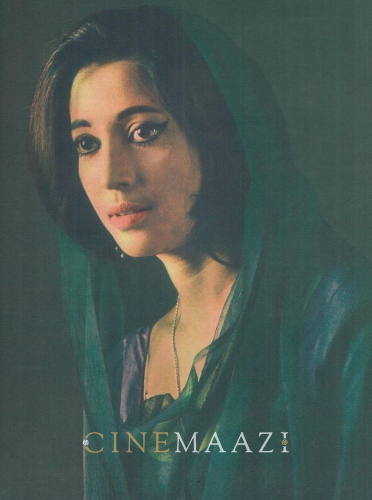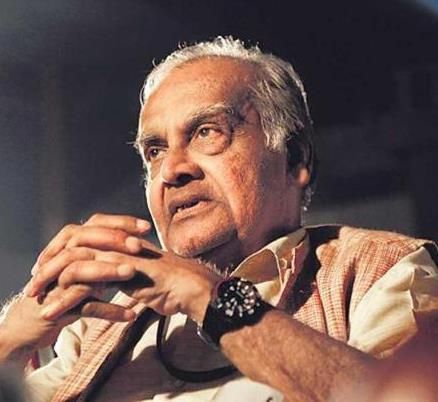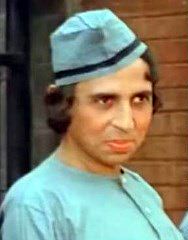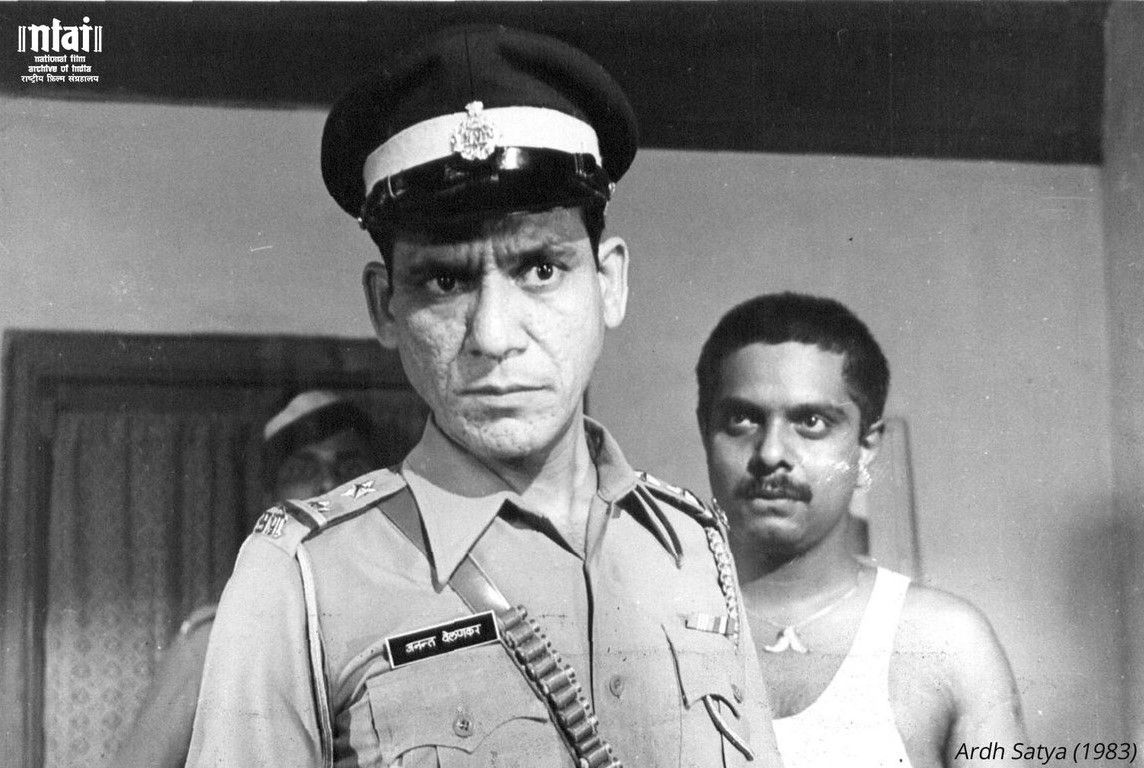Ardh Satya (1983) is a film directed by Govind Nihalani and written by Vijay Tendulkar which starred Om Puri, Smita Patil, Amrish Puri and Naseeruddin Shah. Ardh Satya, the title of the movie which means ‘Half Truth’ is inspired from Dilip Chitre’s poem by the same name. As the movie unfolds the poem’s relevance to the main characters comes to the front. The movie begins with Anant Welankar, (Om Puri) the protagonist at a party where he meets Jyotsna (Smita Patil) and the two forge a connection that leads to frequent rendezvous. Anant Welankar is a young idealist who has joined the police on his father’s insistence and Jyotsna is a young liberal woman who is part of the intelligentsia.
In the first half of the movie, we see Anant trying to uphold his morals and perform his duty in a world where corruption and political influence is the norm. His frequent encounters with mobster Rama Shetty (Sadashiv Amrapurkar) bring forth this struggle and show the existing nexus between the local criminals, the police and the politicians. In one such instance where Anant captures and beats members of Rama Shetty’s gang for sexually harassing a woman, he is threatened with suspension and enquiry. In order to escape this Anant ends up taking help from a politically influential person from Delhi. He soon realises his morals and ideals have to be circumvented to survive in an institution that is plagued with political constraints and considerations or meet the same fate as Mike Lobo (Naseeruddin Shah). Lobo is an ex-police officer who is reduced to an alcoholic and can be perceived as a constant reminder to Anant of a not so different fate he might meet if he continues to do his duty righteously.
The role of his abusive father has a significant impact on Anant’s worldview where he is particularly sensitive to abuse against women.
However, Anant’s moral dilemmas soon lead him to take to alcohol as an outlet of his frustration with the system. When one of Rama Shetty’s men is found burnt alive on the road, Anant gets a written confession from the man in the hospital where he calls out Rama Shetty as the perpetrator. Despite the convincing evidence, when Anant goes to arrest Shetty he is ordered by a senior officer yet again to step back and is threatened with dire consequences. This further adds insult to injury and becomes the last straw for Anant who spirals downward and takes to alcohol as an escape mechanism. For Anant, this instance is not only humiliating but also makes him question his ‘mardangi’ or manhood which is closely linked to the power and authority his uniform is supposed to bring him.
However, Anant clearly fails to understand how women often have to pick their battles cautiously and not act on whims which can put them in harm’s way, thus ending up blaming the victim in the situation. Furthermore, Anant’s need to ‘save’ a woman’s dignity also comes from his guilt of not being able to stand up to his father when he frequently abused his wife.
Anant’s father (Amrish Puri) who himself is in the police is shown as an autocratic father who has no care for his son’s wishes and is abusive to his wife. This has been shown in scenes where despite Anant’s wish to study further and become a professor he is forced to join the police to fulfil a family legacy and asked to marry a woman of his parents’ choice. The role of his abusive father has a significant impact on Anant’s worldview where he is particularly sensitive to abuse against women. A scene from the movie which projects this is when Jyotsna and Anant are in a public bus and a man tries to touch Jyotsna inappropriately, Anant loses his temper and starts bashing the man. When Jyotsna tells him that she found his behaviour extreme, he retorts that it is because women tolerate such incidents silently, men continue to misbehave. However, Anant clearly fails to understand how women often have to pick their battles cautiously and not act on whims which can put them in harm’s way, thus ending up blaming the victim in the situation. Furthermore, Anant’s need to ‘save’ a woman’s dignity also comes from his guilt of not being able to stand up to his father when he frequently abused his wife.
Smita Patil’s portrayal of Jyotsna as a headstrong woman who is not afraid to speak her mind is commendable. This becomes clear when she tells Anant that she does not wish to marry him if he continues his job. In one scene she says that sometimes the more you get to know a person, the less it feels you know them. And at some point, we have all felt that.
Smita Patil’s portrayal of Jyotsna as a headstrong woman who is not afraid to speak her mind is commendable. This becomes clear when she tells Anant that she does not wish to marry him if he continues his job. In one scene she says that sometimes the more you get to know a person, the less it feels you know them.
As the movie progresses we find Anant particularly distressed when he does not receive recognition for his contribution to capturing criminals in a dacoity case. He starts drinking copious amounts of alcohol and displaces his anger on a boy accused of some petty offence. This severe abuse power leads to the boy’s death in police custody which is followed by Anant's suspension and a high-level enquiry. In order to deal with this situation, his colleagues suggest he take help from Rama Shetty. Anant reluctantly goes to ‘buy’ help from Shetty but instead of monetary return Rama Shetty wants Anant to work for him within the police and do his bidding. Anant in a moment of rage strangles Rama Shetty to death and in the ending scene surrenders himself to the police. The film shows us how often violence perpetuates violence, as a young boy seeing violence in his family, Anant grows up to join an institution where violence becomes an everyday part of his life which ultimately impacts him as a person and his personal life. The constant tug of war between his values and ethics and the humiliation of not being able to perform his duty takes a toll on his mental and emotional health.
The film shows us how often violence perpetuates violence, as a young boy seeing violence in his family, Anant grows up to join an institution where violence becomes an everyday part of his life which ultimately impacts him as a person and his personal life.
In one scene. the poem from which the film draws its title
Ardh Satya is read by Anant from Jyotsna’s book. While reciting the poem Anant undergoes the realisation that he himself is within the Chakravyuh (Labyrinth) that the poem talks about. In this labyrinth where Anant finds himself, he hardly remembers who he was before entering it and doesn’t know who he will be after he exits the circle. In this Chakravyuh, it does not matter whether he kills or is killed. The poem also talks about balance scales where one side stands for impotence and the other for manhood but right at the middle point of this balance is the half-truth. It can be assumed that manhood here is associated with his duty as a police officer and authority the uniform brings him while impotence can be associated with his failure to stand by his ideals and the humiliation he endures when he fails to perform his duty. Om Puri as Anant has beautifully portrayed the role of a young tortured man who in the course of his job goes through an existential crisis. In one long shot his rendition of the poem particularly gives you chills as the meaning of the words sink in.
In this labyrinth where Anant finds himself, he hardly remembers who he was before entering it and doesn’t know who he will be after he exits the circle. In this Chakravyuh, it does not matter whether he kills or is killed. Om Puri as Anant has beautifully portrayed the role of a young tortured man who in the course of his job goes through an existential crisis. In one long shot his rendition of the poem particularly gives you chills as the meaning of the words sink in.
Some of the issues the movie talks about still have significant relevance in contemporary times. The movie is set at a time when civil society organisations in India and particularly in Mumbai were capturing the imagination of the masses and media. The movie shows us the contemporary context in which it is situated, a time in Mumbai when local mafias and criminals had a strong foothold in the city with undue political influence, where labour unions had started raising their voice against exploitation and intellectuals brought to the fore a myriad of social issues.
One issue the movie talks about is police brutality which is pertinent to the 80’s context wherein cases like the Mathura rape case had sent shockwaves across the country, sparking debates and discussions in public about the issue of custodial violence.
One issue the movie talks about is police brutality which is pertinent to the 80’s context wherein cases like the Mathura rape case had sent shockwaves across the country, sparking debates and discussions in public about the issue of custodial violence. In the movie, as Jyotsna gains exposure on the matter as she tries to discuss with Anant about the recent cases of police brutality. But Anant is quick to dismiss them as media propagating its own biases against the police and he justifies violence as a necessary tool for the police to maintain law and order. One striking part of this conversation is when Jyotsna questions Anant on how the police can justify taking law into their own hands, just to serve their idea of justice and Anant again gives the justification of the greater good of society. What unfortunately the Anants of this world have failed to understand is that it is the function of the judiciary to decide if one is guilty or innocent and separation of powers exists to bring about checks and balances. If police are entrusted with the responsibility to carry out justice however they deem fit, without any trial, courts in a democratic country like ours become meaningless.
There is lack of mental health facilities for the police despite it being a highly taxing job and not enough attention is given to training and sensitization.
But not a lot has changed since then. The fact remains that not only are the methods of investigation in our country archaic and inadequate but the police in the country continue to be overburdened. There is lack of mental health facilities for the police despite it being a highly taxing job and not enough attention is given to training and sensitization. As an institution, it continues to have an unhealthy work culture as projected in the movie where corruption has been internalised and the use of torture and violence seen as the only way of extracting evidence and confessions. This has somewhere negatively impacted the image of the police force in society as well where their presence instils fear among the general public instead of a sense of security. Despite this, films like
Ardh Satya still show us a nuanced understanding of the kind of realities that personnel in the police are often faced with. This is not reflected in modern movies on police where they blindly endorse police vigilantism where the police officer becomes a hero by taking law into their own hands. As Nihalani’s previous film
Aakrosh (1980),
Ardh Satya is another movie which still finds relevance in today’s world and talks about the interplay of violence and morality in people’s lives.








.jpg)


